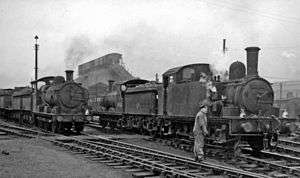GER Class C72
| GER Class C72 LNER Class J68 | |||||||||||||||||||||||||||||||||||
|---|---|---|---|---|---|---|---|---|---|---|---|---|---|---|---|---|---|---|---|---|---|---|---|---|---|---|---|---|---|---|---|---|---|---|---|
 J68 0-6-0T No. 68642 at Stratford Locomotive Depot February 1961 | |||||||||||||||||||||||||||||||||||
| |||||||||||||||||||||||||||||||||||
| |||||||||||||||||||||||||||||||||||
| |||||||||||||||||||||||||||||||||||
| |||||||||||||||||||||||||||||||||||
The GER Class C72 was a class of thirty 0-6-0T steam locomotives designed by A. J. Hill for the Great Eastern Railway. They passed to the London and North Eastern Railway (LNER) at the 1923 grouping and received the LNER classification J68.
History
These locomotives were an improved version of the Class S56 tanks, and the final development of James Holden's Class T18 tank locomotives, sharing the same 16.5-by-22-inch (419 mm × 559 mm) cylinders, 4-foot-0-inch (1.219 m) driving wheels, and 13-foot-10-inch (4.22 m) wheelbase. There were three orders, each of ten locomotives, all built at Stratford Works between 1912 and 1923. The first batch were built as suburban passenger tanks and were fitted with Westinghouse air brakes. The second and third batches were built as shunting tanks and were fitted with steam locomotive brakes and vacuum train brakes.
| Year | Order | Quantity | GER Nos. | LNER Nos. | 1946 Nos. | Notes |
|---|---|---|---|---|---|---|
| 1912 | C72 | 10 | 41–50 | 7041–7050 | —, 8638–8646 | Passenger service |
| 1913–14 | G75 | 10 | 21–30 | 7021–7030 | 8647–8656 | Shunting service |
| 1923 | L89 | 10 | 31–40 | 7031–7040 | 8657–8666 | Shunting service |
The last batch did not emerge from Stratford until after the grouping.
One locomotive was lent to the War Department in October 1939,[2] and sold 12 months later,[3] It was used on the Longmoor Military Railway before being moved to the Bicester Central Ordnance Depot,[2] and then the Military Port No. 1, Faslane.[4] The remaining locomotives were renumbered 8638–8666 in order of construction. At nationalisation in 1948 they passed to British Railways, who added 60000 to their numbers. Post war withdrawals started in 1958, and all were gone by 1961.
| Year | Quantity in service at start of year | Quantity withdrawn | Locomotive numbers | Notes |
|---|---|---|---|---|
| 1940 | 30 | 1 | 7041 | to WD 85 |
| 1958 | 29 | 6 | 68651, 68653, 68659, 68662, 68666, 68664 | |
| 1959 | 23 | 5 | 68638, 68639, 68640, 68648, 68658 | |
| 1960 | 18 | 10 | 68641, 68643, 68645, 68652, 68654–68657, 68661, 68665 | |
| 1961 | 8 | 8 | 68642, 86646, 68649, 68650, 68644, 68647, 68660, 68663, | |
References
- ↑ Aldrich 1969, p. 104
- 1 2 Tourret 1995, p. 47
- 1 2 Aldrich, p. 105.
- ↑ Tourret 1995, p. 48
- Aldrich, C. Langley (1969). The Locomotives of the Great Eastern Railway 1862–1962 (7th ed.). Wickford, Essex: C. Langley Aldrich. OCLC 30278831.
- Baxter, Bertram (2012). Baxter, David; Mitchell, Peter, eds. British Locomotive Catalogue 1825–1923, Volume 6: Great Eastern Railway, North British Railway, Great North of Scotland Railway, Midland & Great Northern Joint Railway, remaining companies in the LNER group. Southampton: Kestrel Railway Books. pp. 103–104. ISBN 978-1-905505-26-5.
- Tourret, R. (1995). Allied Military Locomotives of the Second World War. Abingdon, Oxon: Tourret Publishing. ISBN 0-905878-06-X.
External links
- R24, R24R, S56 and C72 Classes 0-6-0T — Great Eastern Railway Society
- The Hill J68 (GER Class C72) 0-6-0T Locomotives — LNER Encyclopedia